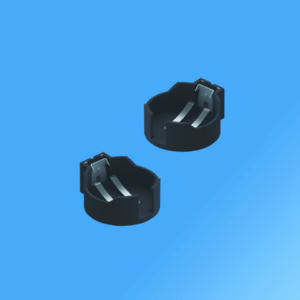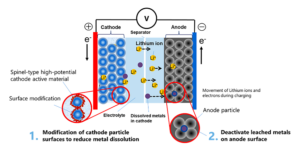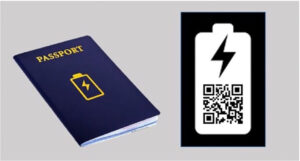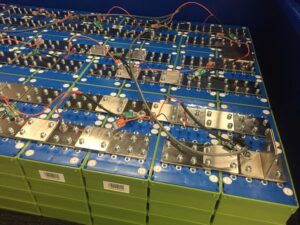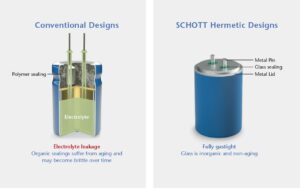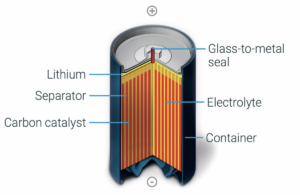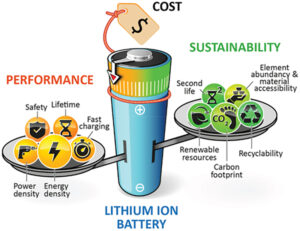A breakthrough lithium coin cell holder for maximizing PC board capacity when installing high-capacity 2477 lithium coin cells in high-density applications is now available from Keystone Electronics. Its top-loading design allows for minimal footprint board layouts without restricting battery access in devices. This sturdy holder is supplied in a thru-hole version and is extremely rugged,…
Trigger alerts when Li-ion batteries get too hot
TTape from Littelfuse, set of temperature-triggered switches, raises a bit that indicate hot batteries. Li-ion batteries can get hot, which can cause failures or worse in the products they power. Thus, it’s important to monitor their temperature and act before damage occurs. You can monitor temperature with a set of thermocouples, scan them, and write…
New lithium-ion battery with cobalt-free 5V class high-potential cathode
Toshiba Corporation has developed a new lithium-ion battery using a cobalt-free 5V-class high-potential cathode material that significantly suppresses performance-degrading gases produced as side reactions. This battery can operate in a wide range of applications, from power tools to electric vehicles. Cobalt and nickel are widely used to stabilize the cathodes of lithium-ion batteries. However, cobalt…
US Department of Energy confirms California’s Salton Sea as a rich lithium resource
The US Department of Energy (DOE) announces the results of the most comprehensive analysis to date quantifying the domestic lithium resources in California’s Salton Sea region. Conducted by DOE’s Lawrence Berkeley National Laboratory, the analysis found that with expected technology advances, the Salton Sea region’s total resources could produce more than 3,400 kilotons of lithium,…
Lithium Iron Phosphate cell capable of charging from 20% to 80% in six minutes
DESTEN Inc. announced the launch of the latest cell technology advancement, an Ultra-Fast Charging, 6C LFP (Lithium Iron Phosphate) cell. The latest pouch form-factor cell from DESTEN is capable of charging from 20% to 80% SOC in 6 minutes. Owing to its LFP-based chemistry, this cell features an impressive chemical and temperature stability profile, making…
What is a lithium battery digital passport?
A digital battery passport provides easy access to structured, reliable, and complete information about the battery. This fresh initiative in the US lithium battery landscape aims to simplify consumers’ choice and use of batteries. The US government agencies are working on battery passport requirements, centralizing battery specifications and pertinent details, making it user-friendly for the…
Design the right BMS for LiFePO4 batteries
By JD DiGiacomandrea, Green Cubes Technology Learn why Lithium-ion-phosphate batteries need the right battery-management system to maximize their useful life. It’s all about chemistry. Lithium-ion (Li-ion) batteries provide high energy density, low weight, and long run times. Today, they’re in portable designs. Their popularity has spawned a few sub-chemistries that all use the principle of…
How do consumer and industrial Li batteries differ?
Consumer (sometimes referred to as commercial) lithium (Li) batteries offer better performance compared with lower-cost alkaline, nickel-cadmium (NiCd), or nickel metal hydride (NiMH) alternatives, but industrial Li batteries are even higher in performance. This FAQ looks at examples of chemistries for primary and secondary Li batteries in consumer and industrial devices including the use of…
How do the six most common Li primary chemistries compare?
Rechargeable lithium-ion batteries get a lot of headlines, but primary Li battery chemistries are the workhorses in a large number of industrial, medical, consumer, and other applications. This article looks at the performance tradeoffs and typical applications for the six most common Li primary chemistries including LiCFX (lithium poly carbon monofluoride) LiMN02 (lithium manganese dioxide),…
How can primary Li batteries contribute to sustainability?
A lot has been written regarding rechargeable lithium (LI) batteries and sustainability. Primary (non-rechargeable) Li batteries can also make major contributions to improving the sustainability of the systems where they are used. This FAQ reviews some of the factors related to the sustainability of primary Li batteries including key performance indicators (KPIs), downcycling versus recycling,…

